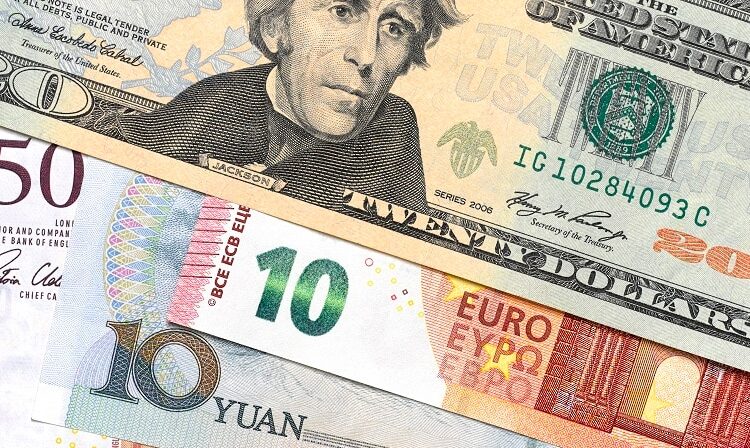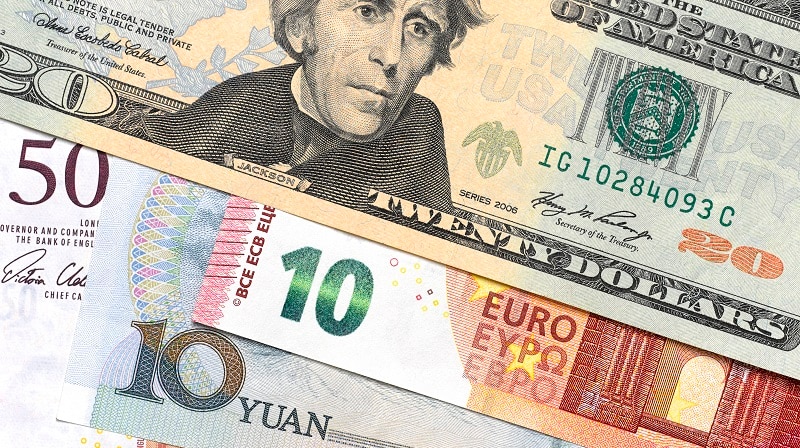

The U.S. dollar is on a roll. Even as the American economy shows signs of cooling, the greenback has soared against major currencies from Europe’s 19-member euro to the Chinese renminbi. An index of the dollar versus other major currencies is trading around a two-decade high.
Investment tends to flow into higher yielding currencies, and the greenback has rallied in part because the Federal Reserve is hiking interest rates more aggressively than some other central banks as it seeks to contain inflation, according to Kamakshya Trivedi, head of Global Foreign Exchange, Interest Rates and Emerging Markets Strategy Research. The dollar, which is seen as a haven during turmoil, has also risen as concerns grow that the shock in energy prices will stall economic growth in many parts of the world.
But Trivedi says there are signs that the dollar’s rise is in its “later innings,” as it nears extreme levels against currencies like the Japanese yen or the British pound, which has traded at its weakest level against the greenback since Margaret Thatcher was the U.K. prime minister. We spoke with Trivedi about the risks to emerging-market currencies from the dollar’s rally and his outlook for the world’s reserve currency.
What are some of the key factors that are underpinning the U.S. dollar’s strength against major currencies?
First, you have relative policy differences between the U.S. and other major regions of the world. The U.S. economy seems to be on a firmer footing, inflation looks to be more broad-based, and the Federal Reserve appears to be more unconstrained in terms of raising policy rates and tightening policy than many other parts of the world.
To give you an example, the European Central Bank has been moving policy in a pretty aggressive fashion as well, but they have to have half an eye on whether policy tightening generates concerns on sovereign credit, and whether it creates financial fragmentation. Across Europe, concerns around the energy shock are top of mind. By contrast, the Fed has been able to move more aggressively, more proactively, in terms of tightening policy.
The dollar is also special, and this is the second part. It tends to perform well when there are concerns of global recession, and there’s a risk-off mood in markets. The dollar is a ‘safe haven’ asset, and you tend to see flows back into the dollar that support the currency as well.
For most of this year one or both of those forces have been in operation. Much of the dollar strength in the first quarter was about the Fed just moving more aggressively and the market pricing that relative to others. Second quarter it had a bit more of that recession-type flavor where the dollar did well against a broad swath of both developed and emerging-market currencies, because recession concerns were top of mind. As we go through the third quarter it’s sort of gone back a little bit to the flavor of the first quarter where the consistent and big moves by the Fed once again appear to be supporting the dollar against major currencies.
Is the dollar’s rally creating any concerns for developed market currencies? For example, there’s been media speculation about an intervention in the Japanese yen and an emerging market-style crisis in the U.K. pound.
There has been a lot of discussion around these issues. Let me start with the U.K.: The first thing I want to acknowledge is the situation is definitely challenging. There has been a significant shock in terms of the energy price pressures, and no government policy can fully offset that. But I think we are a long way away from the emerging-market style balance-of-payment-type crisis in the U.K. Those things tend to happen when you have a fixed exchange-rate regime, and a lot of external debt denominated in dollars or a foreign currency. Those are not features of the U.K.
My sense is that we’re just coming off a summer where there has been some uncertainty about government formation and government policy, and there’s been somewhat of a hands-off approach from policymakers as a result of that.
Now that you have some clarity in the fiscal response, there is a prospect for the Bank of England to move in a more forceful fashion as well. That should put some of these some of these crises-type stories to rest. But there’s no question the energy shock weighs on the U.K.’s external balance, and the weaker pound is itself an adjustment mechanism to that external shock. So some degree of weakness that we have seen seems warranted, but I would caution against kind of extrapolating that too far and thinking about an EM-style crisis.
The yen, in a way, is even more interesting. Yes, the yen has weakened a lot versus the dollar, it’s at levels that are close to historically weak levels for that currency. But again, it’s important to remember that a weaker yen is a direct outcome of the policy setup that the Bank of Japan has put in place, and that is meant to weaken the yen at times like this. Yield-curve control, where the Bank of Japan fixes its yields even as yields and interest rates are going up everywhere else in the world, is meant to generate yen weakness and therefore kickstart the domestic inflation process.
It’s natural for market participants to look at these stretched levels, whether they are in the pound or the yen, and worry about a response and whether these moves are going to be arrested. But it’s important to step back and think about what is causing it. While policies can shift, we think the weaker yen, weaker pound, are a direct outcome of the shocks and policies that have been playing out.
And how about for emerging markets? Does the dollar’s strength risk causing strains in any of those currencies?
That is a place where I think concerns are more genuine. Certainly there are pockets of emerging markets where you do have some of those features — fixed exchange rates, foreign-currency denominated debt — and where, as a result of the dollar strength, and higher U.S. interest rates over the past or the past several months, there have already been meaningful problems.
There are a number of those emerging markets that have been forced into what I would describe as corner solutions. Either they have been forced to default on their foreign currency debt, and Sri Lanka is an example, or engage with the International Monetary Fund, like Pakistan and Egypt. Several other countries also have their foreign-currency credit spreads trading at very distressed levels.
For that group of countries, what I would describe as frontier emerging markets, those concerns are genuine, but in many cases are either already reflected in prices, or indeed in their engagement with IMF.
Much of the weakness across broader EM — for example in the South African rand or the Indian rupee versus the dollar — reflects challenges that are qualitatively not dissimilar to many DMs: Policy rate increases that have struggled to outpace the U.S. Fed, for example, and shocks to energy prices that have exacerbated current account deficits. The challenge for these EMs is that weaker currencies complicate what is already a tough challenge of bringing inflation and inflation expectations under control.
How far along are we in this cycle in terms of dollar strength? Is it past its peak?
The dollar has been strengthening for some time already. On some measures of the broad dollar, it has strengthened something like 15% this year, 20% since the start of 2021. On a valuation basis, the dollar does look overvalued. Maybe not quite as overvalued as previous peaks but not that far from those levels either. And when you look at the individual currency pairs like I was describing, versus the yen or versus the pound, you are at levels that look relatively extreme.
When you put all of that together, I think it’s probably fair to say that we are in the later innings of this cycle of dollar strength. We still think that the dollar has a bit more room to strengthen, in part because of those factors that I mentioned at the outset. We still think they are in play.
We forecast the U.S. economy to continue to do somewhat better than other major economies such as the euro area and China. As a result, we also expect the Fed to continue to be on the front foot when it comes to its policy-tightening process, and that should continue to support the dollar from these levels. But I think it’s fair to say we are late in this cycle of dollar strength.
Is dollar strength a headwind or a tailwind for the U.S. economy?
On net, the dollar strength is a headwind for the overall U.S. economy. A strengthening dollar is often part of any tighter financial conditions mix that policy makers focus on when they’re trying to slow the economy.
But it is also obviously an important factor in driving the inflation process. A stronger dollar causes the domestic price of imported goods to be lower, and I would argue that at this juncture, where inflation seems much too high and much more out of whack relative to target, U.S. policy makers are probably looking at the stronger dollar and are quite pleased with the help they are getting on the inflation front, rather than the fact that, on net, it’s a little bit of a headwind on activity.
Inflation is the bigger priority currently, and therefore, while it may not be large, whatever help you can get from a stronger dollar for the domestic inflation metrics, I think it is not unwelcome.
Which other currency pairs are particularly important to watch right now?
The euro dollar is always an important currency pair to watch. It’s at a key level right now, hovering around parity versus the dollar. Much of what happens to the broad dollar is going to be very correlated with what happens to the euro and the euro area outlook. Our economists are still fairly downbeat and expect a recession in the euro area, and accordingly we expect the euro to trade below parity for the next three months or so.
The Chinese renminbi is another place where we expect to see more weakness and more dollar strength over the next two to three months. Again, at a very simple level, it reflects the fact that China’s economy is also struggling somewhat, both because of the successive local lockdowns on account of the zero-Covid policy alongside continued troubles in the domestic property sector.
The difference in relative policy settings is perhaps clearer in China than most places: You have a Fed that is raising rates even with the U.S. economy slowing, and then you have the People’s Bank of China which is lowering rates given the kind of struggles the economy is facing. The upshot of those two things is that we expect the dollar-renminbi cross to continue moving higher and the renminbi to continue to weaken.



